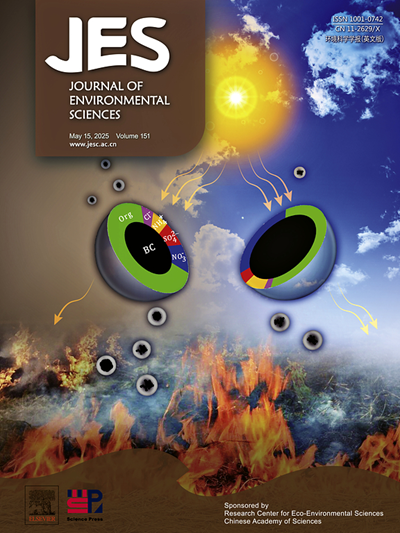单晶α-Fe2O3纳米六方修饰网印碳电极对镉(II)的精确检测
IF 5.9
2区 环境科学与生态学
Q1 ENVIRONMENTAL SCIENCES
引用次数: 0
摘要
即使浓度很小,铅、镉和汞等有毒金属对环境和人类健康也是危险的。环境监测依赖于精确识别这些重金属,特别是镉离子(Cd(II))。在这项研究中,我们提出了一种用单晶α-Fe2O3纳米六边形修饰的新型丝网印刷碳电极(SPCE),它可以作为检测Cd(II)的传感器。利用伏安法对该传感器的性能进行了全面评估,并与未修改的SPCE进行了比较。通过XRD对合成的α-Fe2O3纳米六边形的晶体结构进行了表征,表面形貌分析表明,α-Fe2O3纳米六边形的平均直径为86 nm,平均厚度为9 nm。α-Fe2O3修饰的SPCE对Cd(II)的响应(pH 5.0 vs. Ag/AgCl)比裸SPCE提高了7倍。在理想条件下,该电极对Cd(II)的线性响应范围可达333.0µM,检出限为0.65 nM。这种新制造的传感器通过提供出色的实用性、抗干扰能力和可重复性来检测水样中的Cd(II),为环境监测应用提供了巨大的潜力。本文章由计算机程序翻译,如有差异,请以英文原文为准。
Accurate cadmium (II) detection with single crystalline α-Fe2O3 nano-hexagonal modified screen-printed carbon electrode
Even in small concentrations, toxic metals like lead, cadmium, and mercury are dangerous to the environment and human health. Environmental monitoring depends on precisely identifying these heavy metals, particularly cadmium ions (Cd(II)). In this study, we present a novel screen-printed carbon electrode (SPCE) modified with single crystalline α-Fe2O3 nano-hexagons that functions as a sensor for detecting Cd(II). The performance of the fabricated sensor was thoroughly assessed and compared with unmodified SPCE using the voltammetric method. The crystalline structure of the synthesized α-Fe2O3 nano-hexagons was confirmed through XRD, and surface analysis revealed an average diameter and thickness of 86 nm and 9 nm, respectively. The α-Fe2O3 modified SPCE yields a 7-fold enhanced response (at pH 5.0 vs. Ag/AgCl) to Cd(II) than bare SPCE. The modified electrode effectively detects Cd(II) with a linear response range of up to 333.0 µM and a detection limit of 0.65 nM under ideal circumstances. This newly fabricated sensor offers significant potential for environmental monitoring applications by providing outstanding practicality, anti-interference ability, and repeatability for detecting Cd(II) in water samples.
求助全文
通过发布文献求助,成功后即可免费获取论文全文。
去求助
来源期刊

Journal of Environmental Sciences-china
环境科学-环境科学
CiteScore
13.70
自引率
0.00%
发文量
6354
审稿时长
2.6 months
期刊介绍:
The Journal of Environmental Sciences is an international journal started in 1989. The journal is devoted to publish original, peer-reviewed research papers on main aspects of environmental sciences, such as environmental chemistry, environmental biology, ecology, geosciences and environmental physics. Appropriate subjects include basic and applied research on atmospheric, terrestrial and aquatic environments, pollution control and abatement technology, conservation of natural resources, environmental health and toxicology. Announcements of international environmental science meetings and other recent information are also included.
 求助内容:
求助内容: 应助结果提醒方式:
应助结果提醒方式:


